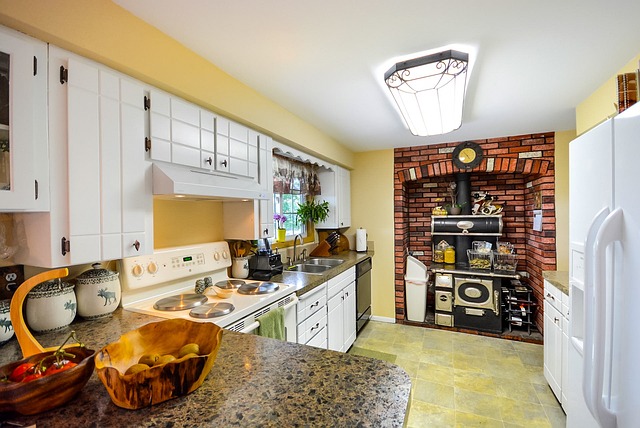A barrier-free kitchen layout prioritizes accessibility and functionality for all users through key design elements like lower countertops, adjustable islands, and customizable storage. The core innovation lies in task-specific lighting, which includes adjustable undercabinet lights and smart controls that cater to diverse needs, from visual impairments to limited mobility. By offering versatile illuminance levels and directions, this setup ensures comfort, safety, and independence during various kitchen tasks. Integrating dimmer switches and smart controls further enhances adaptability, allowing users to customize lighting for specific activities like coffee making or meal gatherings, thus creating an enjoyable, accessible, and energy-efficient cooking environment.
In the pursuit of creating functional and accessible spaces, understanding barrier-free kitchen design principles is paramount. This article explores how adjustable and task-specific lighting options play a pivotal role in enhancing accessibility and efficiency. From smart controls to dimmer switches, we delve into innovative solutions that cater to diverse user needs.
Through real-world case studies, we showcase successful implementations of adaptive lighting, demonstrating its impact on creating inclusive barrier-free kitchen layouts. Discover how these strategies can transform your space, ensuring comfort and practicality for all users.
Understanding Barrier-Free Kitchen Design Principles
A barrier-free kitchen design focuses on creating a functional, accessible space for everyone, regardless of physical abilities or limitations. This principle is essential in ensuring that all individuals can move freely and comfortably within the kitchen, enabling easy access to countertops, appliances, and storage areas. By implementing a barrier-free kitchen layout, you promote independence and safety for users with mobility issues, back problems, or other physical challenges.
Key elements of this design philosophy include lower countertops and cabinets for easier reach, adjustable height islands or tables, and strategically placed storage solutions. These features cater to various user preferences and physical needs, allowing for personalized task-specific lighting options as well. Such customization ensures that lighting can be tailored to specific activities, enhancing visibility and comfort during food preparation, cooking, or cleaning tasks.
The Role of Adjustable Lighting in Creating Accessibility
Adjustable lighting plays a pivotal role in creating accessible spaces, particularly in areas like the barrier-free kitchen layout. By offering adjustable luminance levels and customizable direction, task-specific lighting solutions cater to diverse user needs, including those with visual impairments or limited mobility. This flexibility ensures that everyone can perform kitchen tasks comfortably and safely, promoting independence and inclusivity within the space.
In a barrier-free kitchen, adjustable undercabinet lights, for instance, can be positioned to illuminate specific work areas without causing glare, making it easier for users to prepare meals or access storage. Additionally, task lighting above prep stations or cooking surfaces can be adjusted to provide the exact amount of light required for various activities, from reading recipes to chopping vegetables. This thoughtful approach to lighting enhances functionality and accessibility, reflecting modern design principles aimed at creating inclusive environments.
Task-Specific Lighting: Enhancing Efficiency and Comfort
Task-specific lighting is a game-changer for any space, especially in areas like the barrier-free kitchen layout. By incorporating adjustable task lights, you can ensure that each area serves its intended purpose with optimal visibility. For instance, under-cabinet lighting directs light precisely where needed, allowing chefs to prepare meals efficiently without strain. Similarly, overhead fixtures with dimmable settings offer general illumination while tasks require more focused attention. This flexibility not only enhances productivity but also ensures comfort for users of all abilities.
In a barrier-free kitchen, task-specific lighting considerations become even more critical. It ensures that everyone can move around freely and engage in various activities without barriers to visibility. Whether it’s reading recipes, chopping vegetables, or serving dinner, the right lighting allows for seamless transitions between tasks, making the kitchen a more inclusive and enjoyable space for all.
Integrating Dimmer Switches and Smart Controls
In a barrier-free kitchen layout, integrating dimmer switches and smart controls is a game-changer for creating versatile and customizable lighting environments. Dimmer switches offer the ability to adjust light levels seamlessly, from soft ambiant glows to bright task illumination, catering to various activities throughout the day. By installing these switches in strategic locations, users can effortlessly set the desired ambiance, promoting comfort and functionality.
Smart controls take this a step further by providing automated and customizable lighting scenarios tailored to individual preferences. These advanced systems allow for pre-set lighting levels and schedules, ensuring that the kitchen’s lighting adapts seamlessly to different tasks, from morning coffee preparation to evening meal gatherings. With just a touch or voice command, users can navigate through a labyrinth of lighting options, creating a dynamic and accessible space.
Case Studies: Successful Implementations of Adaptive Lighting
In various settings, from hospitals to offices and homes, successful implementations of adaptive lighting have showcased their benefits. One notable example is the barrier-free kitchen layout in modern residential designs. Here, adjustable lighting plays a pivotal role in enhancing functionality and accessibility. Task-specific lighting options ensure that areas like food preparation stations are illuminated optimally, reducing eye strain for occupants.
These case studies highlight how adaptive lighting systems can cater to individual preferences and needs. In the barrier-free kitchen, dimmable lights and customizable color temperatures allow users to adjust settings according to their tasks—from cooking to reading recipes or enjoying mealtimes. Such implementations not only improve overall user experience but also contribute to energy conservation by illuminating only the necessary areas at specific times.
Incorporating adjustable and task-specific lighting options is a key aspect of designing a barrier-free kitchen, promoting accessibility and efficiency. By understanding these principles and implementing features like dimmer switches and smart controls, designers can create functional spaces tailored to individual needs. Case studies demonstrate the successful integration of adaptive lighting, showcasing how it enhances user experience and navigability in kitchens, making them more inclusive for everyone.
